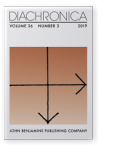Vol. 36:3 (2019) ► pp.337–383
Borrowing from an unrelated language in support of intragenetic tendencies
The case of the conditional clitic =sa in Udi
Udi is a Nakh-Daghestanian (Lezgic) language spoken in northern Azerbaijan, which has undergone many contact-induced changes due to the influence of unrelated languages of the eastern Caucasus (Indo-European, Turkic). A recent change is the borrowing of the conditional enclitic =sa from Azerbaijani (Turkic). In Udi, this marker can combine with finite indicative tenses, resulting in a series of derived ‘realis’ conditional mood forms. The clitic is also used to create an indefiniteness marker, which derives indefinite pronouns from interrogative ones. Prior to the borrowing of the Azerbaijani morpheme there was no comparable marker in Udi available to fulfil these functions, while other Lezgic languages employ their own native grammatical means for the same functions (conditional clitics or auxiliaries). The acquisition of the borrowed clitic has thus made Udi more and not less structurally isomorphic with respect to the other languages of the Lezgic branch. This paper develops a description of functions related to the domain of conditional mood on various stages of the history of Udi, and suggests a diachronic scenario for the borrowing of the Azerbaijani marker =sa.
Article outline
- 1.Introduction
- 2.The Udi language and its contact situation
- 3.Functions of the conditional clitic =sa in Nizh Udi
- 3.1Conditional clauses
- 3.2Clauses with wh-words
- 3.3Comparative constructions
- 3.4Contrastive topic
- 3.5Indefinite pronoun series marker
- 4.The Azerbaijani source of Udi =sa
- 4.1Conditional copula in Azerbaijani
- 4.2Towards the history of =sa borrowing
- 4.3Two possible alternative sources
- 5.The situation in earlier stages of Udi
- 6.Conditional markers in related Lezgic languages
- 7.The conditional =sa vs. other contact-induced changes in Udi
- 8.Conclusions
- Acknowledgements
- Notes
- Abbreviations
-
References -
Published sources in Nizh Udi
